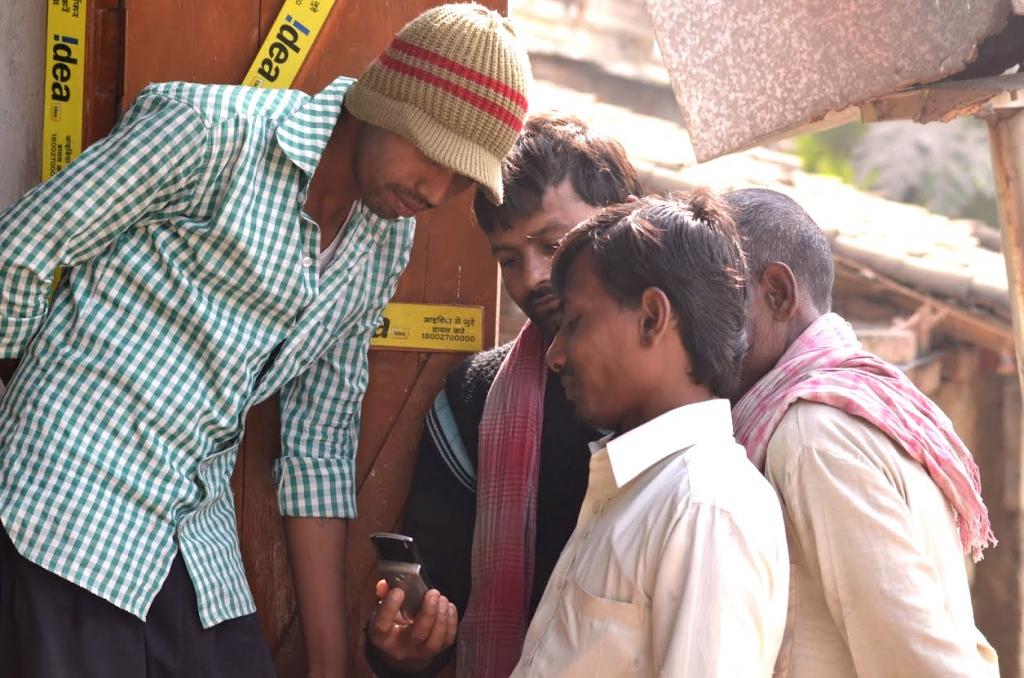How village shopkeepers spread the word on climate-smart agriculture

By engaging with local entrepreneurs and tapping into the reach of mobile phones, CCAFS South Asia hopes to reach our videos on climate-smart agriculture practices to as many farmers possible.
For many farmers in Bihar, a mobile phone is usually the only piece of technology they own.
Says shopkeeper Sanjay Kumar Singh:
“People here now prefer mobile phones with video. These phones are available for about 1,500 Rupees (24 $US).”
As an enterprising kiosk owner in Bochaha village in Muzaffarpur district of Bihar, India, Singh sells mobile phones, top-up cards and internet services and knows all about the most popular phone models and the most sought after features. He is one of 40 kiosk owners in Vaishali and Muzaffarpur districts in Bihar who is sharing CCAFS videos on climate-smart agriculture with his customers. He stores the short videos, about 15 in all, on his computer and if a customer is keen to have them, can upload them on their phone in just a few minutes.
Watch video on how kiosk owners share the climate-smart agriculture clips:
Mobile phone shops are a one-stop-shop for all basic ICT needs in a village and are an important communication hub at the local level.
By using existing services and engaging with local entrepreneurs, CCAFS is working with partner organisation, ViDocs, to scale out this model of video dissemination among resource-poor communities. The videos are an important communication tool in highlighting our work on Climate-Smart Villages.
Useful extension material
Filmed in Hindi, they highlight best practices in conservation agriculture and include farmers’ testimonials from villages in Bihar and Haryana. But hosting these videos online on our YouTube channel does not reach farmers or local extension workers who can benefit the most from them.

Farmers in Bihar can now get the videos on climate-smart agriculture saved directly on their phones, courtesy of selected kiosk owners. (Photo: V. Reddy)
A yawning digital divide
Only 12 percent of India’s population have access to internet. Of the 200 million internet users, there is a stark digital divide between urban and rural areas.
According to a National Sample Survey Organisation (NSSO) report in 2012, only 3 households per 1,000 families have access to the internet in rural areas. Going by these numbers, many farmers in rural Bihar are excluded from the Internet revolution. Putting the films on farmers’ mobile phones lets them ‘own’ the videos and view them at their convenience.
As pointed out by Singh in the film above, many of his customers are not literate and videos remain a powerful and engaging way to communicate in his community. Kiosk owners say they have received six to eight requests a day for the climate-smart films.
“I went to the shop and noticed he had these new videos on agriculture. I thought they could be quite useful to me, so I got them uploaded on my phone,” says Dhashan Kumar Paswan, a farmer from Vaishali district in Bihar.
The films are also screened in busy markets and village fairs. They have been screened in 180 villages in Muzaffarpur, Jamui and Vaishali districts in Bihar to create awareness on the advantages of zero-tillage, agroforestry, laser-land levelling and weather advisories, among other climate-smart agriculture practices. The idea is to highlight how these technologies and practices can work in combination to build resilience to climate change. Sanjeev Kumar, a farmer, who attended one screening said:
“I had heard about a zero-till machine and seen advertisements in the newspaper but this is the first time I saw it in operation, through the film.”
As more and more farmers like Dhashan Kumar and Sanjeev find the videos informative and want to learn more about climate-smart agriculture, we hope to build knowledge and awareness around these agriculture practices and highlight the long-term benefits farmers can reap from adopting them.
CCAFS South Asia will undertake a more detailed analysis of which farmers are able to access information this way and whether and how it really impacts farming activities.
Watch all climate-smart village videos:
This blogpost was written by Dharini Parthasarathy, Communications Specialist, CCAFS South Asia with inputs from Vinaynath Reddy, filmmaker with ViDocs.


